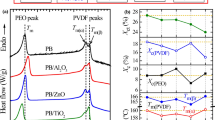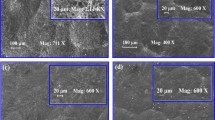Abstract
Emeraldine base (EB) polymer–ZnO nanoparticles composite films has been synthesized by solution casting technique on ITO-coated glass substrate and characterized by XRD, FTIR and TEM for their structure and morphology. Dielectric behaviour of these composite films has been investigated in the very low frequency region to medium frequency region (1 kHz–1 MHz). The dielectric constant of the composite with 30% nanoparticles is almost one-tenth of the pure EB. The dielectric value becomes constant in the frequency region greater than 400 kHz. The change in dielectric behaviour of the composite is explained on the basis of multilayered interface formed between the ZnO nanoparticles and emeraldine chains. Nanoparticles have high energy surface which is responsible for the decrease of free volume for the orientation of polymer chains consequently decrease in dielectric constant of the composite. TEM images shows about 10 nm ZnO particles embedded in the emeraldine matrix. From the XRD data it has been observed that the lattice parameters of ZnO have been modified due to the alignment of polymer chains along the basal planes of the nanoparticles. The shift of N=Q=N and N–B–N vibration bands to higher wave number in IR indicates that interaction between emeraldine chain and nanoparticles which provides stability to emeraldine matrix.






Similar content being viewed by others
References
Andeen D, Lofller L, Padture N, Flange F (2003) Crystal chemistry of epitaxial ZnO on (1 1 1) MgAl2O4 produced by hydrothermal synthesis. Cryst Growth 259:103–109
Bal K, Kothari VK (2009) Mesurement of dielectric properties of textile material and their application. Indian J Fibre Text Res 34:191–199
Cao Y, Smith C, Heeger AJ (1992) Counter-ion induced processibility of conducting polyaniline and of conducting polyblends of polyaniline in bulk polymers. Synth Met 48:91–97
Chen Y, Bangnall DM, Ko H, Hiraga K, Zhu Z, Yao T (1998) Plasma assisted molecular beam epitaxy of ZnO on c-plane sapphire: growth and characterization. J Appl Phys 84:3912–3918
Crisler DF, Cupal JJ, Moon AR (1968) Dilectric piezoelectric and electromechanical coupling costants of zinc oxide crystals. Proc Lett IEEE 56:225–226
Dang ZM, Fan LZ, Zhao SJ, Nan CW (2003) Preparation of nanosized ZnO and dielectric properties of composites filled with nanosized ZnO. Mater Sci Eng B 99:386–389
Gangopadhyay R (2000) Conducting polymer nanocomposites: a brief overview. Chem Mater 12:608–622
Hagemark KI (1976) Defect structure of zinc-doped zinc oxide. J Solid State Chem 16:293–299
Harsányi G (1995) Polymer film in sensor application (technology material devices and their characterization). Technomic Publishing Company, Inc., Lanchaster, pp 34, 99
He Y (2005) A novel emulsion route to sub-micrometer polyaniline/nano-ZnO composite fibers. Appl Surf Sci 249:1–6
Huang HC (2010) Preparation and characterization of highly transparent UV-curable ZnO-Acrylic nanocomposites. Cera Int 36:1245–1251
Joseph Mathai C, Saravanan S, Anantharaman MR, Venkitachalam S, Jayalekshmi S (2002) Characterization of low dielectric constant polyaniline thin film synthesized by ac plasma polymerization technique. J Phys D Appl Phys 35:240
Koch MH, Timbrell PY, Lamb RN (1995) The influence of film crystallinity on the coupling efficiency of ZnO optical modulator waveguides. Semicond Sci Technol 10:1523–1527
Liang S, Sheng H, Liu Y, Hio Z, Lu Y, Shen H (2001) ZnO Schottky ultraviolet photodetectors. Cryst Growth 225:110–113
MacDiarmid AG, Epstein AJ (1989) Polyanilines: a novel class of conducting polymers. Faraday Discuss 88:317–332
MacDiarmid AG, Epstein AJ (1994) The concept of secondary doping as applied to polyaniline. Synth Met 65:103–116
Nelson JK, Hu Y (2004) The impact of nanocomposite formulations on electrical voltage endurance. IEEE-ICSD 7:832–835
Ozgur U, Alivov YI, Liu C, Teke A, Reshchikov MA, Dogan S, Avrutin V, Cho S-J, Morkoc H (2005) A comprehensive review of ZnO materials and devices. J Appl Phys 98:041301
Paul GK, Bhaumik A, Patra AS, Bera SK (2007) Enhanced photo-electric response of ZnO/polyaniline layer-by-layer self-assembled films. Mater Chem Phys 106:360–363
Pouget JP, Jozefowicz ME, Epstein AJ, Tang X, MacDiarmid AG (1991) X-ray structure of polyaniline. Macromolecules 41:723–789
Saito N, Haneda H, Sekiguchi T, Ohashi N, Sakaguchi I, Koumoto K (2002) Low-temperature fabrication of light-emitting zinc oxide micropatterns using self-assembled monolayers. Adv Mater 14:418–421
Seow ZLS, Wong ASW, Thavasi V, Jose R, Ramakrishna S, Ho GW (2009) Controlled synthesis and application of ZnO nanoparticles, nanorods and nanospheres in dye sensitized solar cells. Nanotechnology 20:6
Sharma BK, Gupta AK, Khare N, Dhwan SK, Gupta HC (2009) Synthesis and characterization of polyaniline–ZnO composite and its dielectric behavior. Synth Met 159:391–395
Stejskal J (2002) Polyaniline: preparation of a conducting polymer (IUPAC technical report). Pure Appl Chem 74:857–867
Tan Y, Zhang Y, Thavasi V, Kan J (2009) Synthesis and properties on polyaniline in the presence of nickel chloride. eXPRESS Polym Lett 3:336–337
Tanaka T, Kozako M (2005) Proposal of a multi-core model for polymer nanocomposite dielectric. IEEE Trans Dielectr Electr Insul 12:669–681
Zeng XR, Ko TM (1997) Structure-conductivity relationships of iodine-doped polyaniline. J Polym Sci 35:1993–2001
Author information
Authors and Affiliations
Corresponding author
Rights and permissions
About this article
Cite this article
Singla, M.L., Sehrawat, R., Rana, N. et al. Dielectric behaviour of emeraldine base polymer–ZnO nanocomposite film in the low to medium frequency. J Nanopart Res 13, 2109–2116 (2011). https://doi.org/10.1007/s11051-010-9968-4
Received:
Accepted:
Published:
Issue Date:
DOI: https://doi.org/10.1007/s11051-010-9968-4




